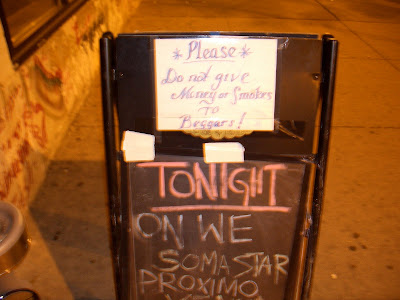When a bar’s business model works, its concept can be successfully copied and transplanted to other neighborhoods or cities. Locally, see
Bar Louie and
John Barleycorn. On the other hand, when a bar makes three separate attempts to make a go of it in the city, as is the case with
Iggy’s 3, it may be a case of trying to force a square mug into a round hole. For a dozen years, the original Iggy’s was a fixture on Milwaukee Avenue, before closing its doors. The second incarnation lasted for 3 years in the Bucktown neighborhood, and, sadly, after an evening at their latest River North venture, one can only wonder about the half-life of the current location.
Iggy’s is clearly an establishment with an identity crisis. It is not truly a restaurant, and it’s not, by a long shot, a full-fledged bar or cocktail lounge. Black and red dominate the motif, with the requisite sock puppet photos from its past locations lining the walls. A small, crescent-shaped bar, with seating for perhaps 8, dominates the front room with several small tables flanking the bar, in a space that can at most seat 50. Iggy’s does provide a hip environment, but the overall vibe is one of style over substance.
As a bar, Iggy’s comes up short. With little space to mingle and fewer spaces to sit, Iggy’s does not lend itself to a comfortable setting for a round of drinks, particularly if the place is crowded. $11 martinis may be the going rate in the city these days, but Iggy’s does nothing to separate its offerings from the crowd. A small, though high-quality, selection of bottled beers are offered to those looking for something lighter, but Iggy’s offers no beers on draught.
As a restaurant, Iggy’s menu seems to be out of line with the atmosphere it is presenting. Appetizers run as high as $15 and entrees to $29, though meals are served by t-shirt clad wait staff who seem more properly attired to slinging buffalo wings. The ambitious menu, combined with the informal service, sends a confusing message to customers. In terms of taste and presentation, a sampled goat cheese appetizer was presented blandly and tasted about the same. Not one sandwich appears on the menu, which may be perfectly suitable for a fine-dining establishment, but it would be a stretch to put Iggy’s in that category.
Overall, Iggy’s is a cool looking spot that needs to decide what it wants to be when it grows up.
Rating: 1 mug
Editor’s note: A negative review is not something that I relish in giving, unlike a slathering Simon Cowell. But until Iggy’s rights the ship, if you’re looking for a drink in that part of River North I might recommend
Clark St. Ale House. For a bite, the authentic and reasonably priced
Café Iberico is a solid bet. (And by the way, the original Bar Louie is just a few blocks west of Iggy’s on Chicago Avenue.)









